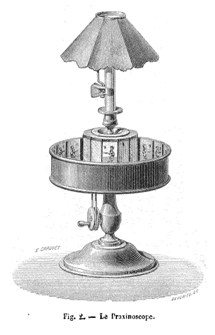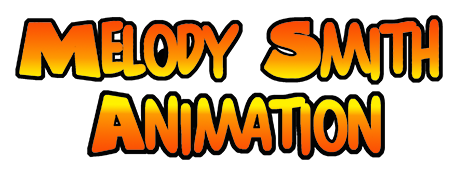Charles-Emile Reynaud (1844-1918 French) |
|
|
Reynaud had both an artistic and photographic background and was clearly influenced by the contemporary inventions around the end of the 19th century. He based the praxinoscope on the zoetrope, making the experience better for the viewer by correcting the distortion of the latter. He did this by removing the zoetrope's slots and 'moving' the image using mirrors reflecting a spinning disk of sequential pictures.
|
|
|
The praxinoscope had a set of 12 mirrors around the outside of a central cylinder. A sequence of 12 pictures taken in succession (see Muybridge) were placed on the inside of a second cylinder, opposite the mirrors. While the two cylinders rotated at the same speed, the viewer looked at the mirrored cylinder to see one 'moving' image created from the reflection of the sequential images. The praxinoscope was primarily sold as a children's toy but Reynaud was keen to extend the market for his invention. |

|
|
He decided to adapt his device to project a moving image onto a screen. Step by step he made improvements which included projecting the 12 images of the praxinoscope onto a screen that also had a stationary background projected onto it. Keen to increase the number of images available, Reynaud then created a leather harness which held a glass plate. A set of these were joined together with perforated metal bands, allowing the glass plates to be moved by a set of hand-cranked, rotating ratchets, unwinding from one cylinder and onto another. Each glass plate was hand painted with the images to be animated. This 'Theatre Optique' allowed more than 12 images to be included in the sequence and was used to show a short movie called 'Un bon bock' (A Good Beer) to a small invited audience in 1888. | |
|
|
In this reconstruction of one of Reynaud's Theatre Optique viewings look for the background projection, the second projection of the reflected images and the hand cranking of the two reels. |
|
Reynaud's invention lead to both the development of cinema and animation. The concept of projecting a set of 'moving' pictures from one reel to another remained in use until the recent digital age. Animating characters by changing their painted image, step by step, while showing them over a separate background is the basis of 2D cel animation and is recreated by layers in digital animation. You can view two of his early works with the Theatre Optique below. The first image in 'Pauvre Pierrot' shows the Theatre Optique set up:
|
Examples of Theatre Optique |
|
|
|
Emile Reynaud: Pauvre Pierrot (1892)
|
|
|
|
Emile Reynaud: Autour d'une cabine (1894)
|







